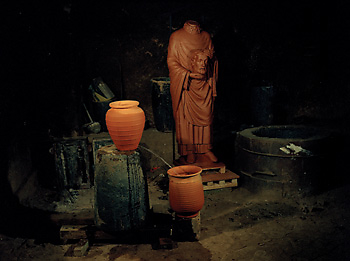When we use the word meteorology, we do so in the Aristotelian sense, which is to say, not in a weather forecasting sense. We should point out that meteors, the subject of meteorology, initially designate the phenomena that travel through the air and interact with the other elements. Thus, Greek meteorology, where it touches on metaphysics, seeks rather to describe the more uncertain movements of the air, in an attempt to explain the rarefaction of the bodies and the big difference between solid bodies, the material and what delicately approaches the blowing of the wind to the inexistent. Aristotelian methodology vis-a-vis meteors provides us with an interpretation for that which occurs, between the land and the sky, as accidental, as exception. It is for this reason that meteorology distinguishes itself from other branches of physics: due to the difficulty of the descriptions of the phenomena and due to the inaccessible nature of their causes. Thus, in Aristotle, we read about how clouds condense, how dry and humid air combine to unleash thunder and lightning and how hurricanes and storms form. The nature of meteors is perplexing he says, but even so some phenomena allow us to attempt an explanation. And reading these first insights into the study of nature today there is a clairvoyance to them, as they admire the real and seek with the imagination what is hidden in the world's naturalness, that is, how the presence of the latter is both characteristic and fleeting at the same time.
We know that for some pre-Socratics the soul corresponds necessarily to the experience of a body whose matter is so ethereal that its explanation can only be compared to the air. Anaximenes, for example, attached great metaphysical importance to the air and it is no accident that he tells us that the breath is the last thing to leave the body and that this final exhalation carries the fire in the soul. This is precisely because the movement of the animate or inanimate bodies seems to depend on the air, because a living being can only move if it breathes, and the dust only lifts when caught by the wind.
For the earliest Greeks, there was clearly a close relationship between the air, the void and the infinite, either because the soul was regarded as a particle so ethereal that it evaporated at death, or simply because the air until the horizon represented seeing as far as the eye could see. However, it follows that the air is still something and proof of this is the reasoning Aristotle uses in Physics: when the philosophers wished to deny the reality of the void, they filled wineskins with air and squeezed them, thus showing that there was resistance, that the air contained something; there was a tiny being in the air.
An idea of meteorology of this kind therefore stems from a principle of puzzlement and conjecture: puzzlement at the phenomena and conjecture about life; of how life is concomitant with the world and of how the world and life must make sense together. In its own particular way, this exhibition has to do with a time perspective of that which relates to the perplexing. These things are best understood if we think of art as still occupying the edges and that its utterances, because they lean towards the eccentric, supply clues to what is hidden.
- João Maria Gusmão, Pedro Paiva and Natxo Checa, June 2009
